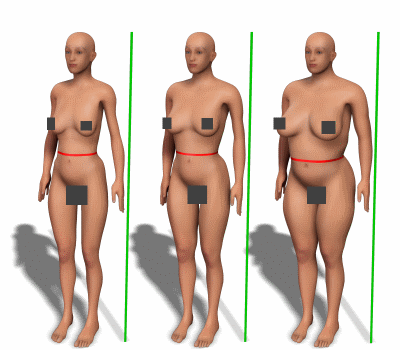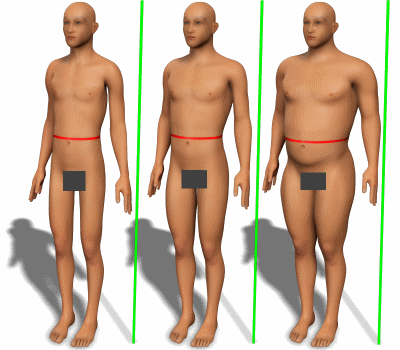Waist to height ratio (WHtR)
With the waist to height ratio the waist circumference is divided by height. The higher the resulting value, the higher the risk for suffering heart and circulation problems. Exact figures for this, however, are not yet known. The value should reveal the risk better than the BMI and the WHR (waist to hip ratio). This was proven by a study from Munich. Source.Formula:
Waist circumference divided by height (both in cm)As a medical term, the WHtR is used as waist-to-height-ratio.

Waist to height ratio for women with various body types. The waist circumference is displayed in red. The height is displayed in green.

Waist circumference compared to height for men with various body types. The waist circumference is displayed in red. The height is displayed in green.
Evaluation of the waist to height ratio
| Children up to 15 | |
|---|---|
| underweight | ...-0,34 |
| normal weight | 0,34-0,45 |
| overweight | 0,46-0,51 |
| obesity | 0,52-0,63 |
| severe obesity | 0,64-... |
| up to 40 years of age | |
|---|---|
| underweight | ...-0,40 |
| normal weight | 0,41-0,50 |
| overweight | 0,51-0,56 |
| obesity | 0,57-0,68 |
| severe obesity | 0,69-... |
| over 50 years of age | |
|---|---|
| underweight | ...-0,40 |
| normal weight | 0,41-0,60 |
| overweight | 0,61-0,66 |
| obesity | 0,67-0,78 |
| severe obesity | 0,79-... |
Correctly measure waist circumference:
- undressed
- in the morning before breakfast
- just above the belly button at the widest part of the stomach
- relax stomach muscles
- breathe out but don’t pull in stomach
- round up to a full centimeter